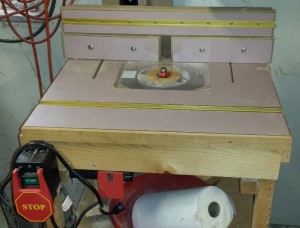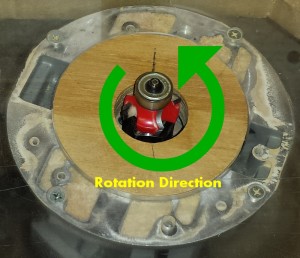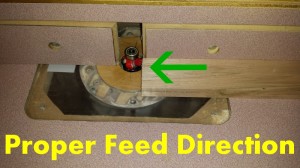 As I go through the process of documenting my router table build, I thought it would be good to have a few posts on proper use of one. When properly used, a router table can be a safe and powerful machine in your arsenal of tools. Unfortunately, as with any tool, improper use can cause severe injury, shooting projectiles, and ruined work pieces.
As I go through the process of documenting my router table build, I thought it would be good to have a few posts on proper use of one. When properly used, a router table can be a safe and powerful machine in your arsenal of tools. Unfortunately, as with any tool, improper use can cause severe injury, shooting projectiles, and ruined work pieces.
 The first thing to understand about using a router table is the direction of spin of the router bit, as this dictates the usage. When mounted in the router table, the router is inverted, so from the users perspective the bit is spinning in a counter clock-wise direction.
The first thing to understand about using a router table is the direction of spin of the router bit, as this dictates the usage. When mounted in the router table, the router is inverted, so from the users perspective the bit is spinning in a counter clock-wise direction.
 When pushing a work piece through the router, it must go against the direction of the spin. For most operations, this translate to moving the work piece from right to left. Going against the spin of the bit will also provide a more accurate cuts as the spin of the bit will pull the work piece into the fence or bearing. This also gives more control of the work piece. Moving the piece with the direction of spin is known as a climb cut. This is a potentially very dangerous operation that can result in the work piece become a projectile, possibly causing injury.
When pushing a work piece through the router, it must go against the direction of the spin. For most operations, this translate to moving the work piece from right to left. Going against the spin of the bit will also provide a more accurate cuts as the spin of the bit will pull the work piece into the fence or bearing. This also gives more control of the work piece. Moving the piece with the direction of spin is known as a climb cut. This is a potentially very dangerous operation that can result in the work piece become a projectile, possibly causing injury.
 There is one operation, that no matter which direction the work piece is sent through results in a dangerous condition. This is trapping a workpiece between the router bit and fence. When pushing right to left, the work piece will very likely fly off of the router table, potentially pulling fingers into a spinning bit. If pushing the work piece from left to right, the work piece will have a tendency to pull away from the fence causing loss of control of the work piece, again creating an unsafe situation. It is best said, don’t ever attempt to run a work piece between the bit and fence.
There is one operation, that no matter which direction the work piece is sent through results in a dangerous condition. This is trapping a workpiece between the router bit and fence. When pushing right to left, the work piece will very likely fly off of the router table, potentially pulling fingers into a spinning bit. If pushing the work piece from left to right, the work piece will have a tendency to pull away from the fence causing loss of control of the work piece, again creating an unsafe situation. It is best said, don’t ever attempt to run a work piece between the bit and fence.

Router table safety is a big issue. Certainly one that I don’t feel adequately prepared to write an article about just yet, however I do have a couple of comments.
In almost every safety article I’ve ever read, people deal with black and white situations. They deal with absolutes, never do this, always do that, etc.
Real world safety is a different matter. Safety has to be functional and not reduce the efficiency and/or functionality of our work. I do certain limited climb cuts, generally if you’re routing an edge profile on a picture frame or something you want to do a short climb cut at the end of the stock to avoid the router ripping the end of the piece apart. It’s part of what we do to turn out high quality work, and if we’re careful and understand the dangers, we can do a lot to minimize them.
I’ve been trying to locate an article I read a while back, it was a Q&A type answer from one of the woodworking magazines, where the author actually admitted that the simple fact is that in order to get the most out of your router table breaking the safety rules (especially regarding feed direction and not doing climb cuts) is somewhat inevitable. There is a huge difference between and informed educated user breaking those rules, and someone whose only exposure has been “don’t do that”.
Great comment! There is appropriate use of climb cuts, however I would consider them as an advanced technique that no one should be trying until they are completely comfortable using the router table, and know what precautions to take in case the piece catches. This may be something I write about on a later post.
I certainly agree with that.
I look forward to reading what you’ve got to say on the topic.